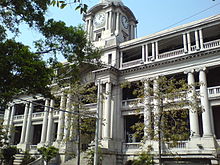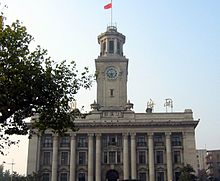- Chinese Maritime Customs Service
-
The Chinese Maritime Customs Service was a Chinese governmental tax collection agency and information service from its founding in 1854 until its bifurcation in 1949 into services operating in the Republic of China on Taiwan, and in the People's Republic of China (see General Administration of Customs)[citation needed]. Until 1912 it was named the Imperial Maritime Customs Service[citation needed].
Contents
Organization
The custom house in Canton built in 1914, the oldest surviving custom house in China
Largely staffed at senior levels by foreigners, the Service was controlled by Chinese central government throughout its history. It was effectively established by foreign consuls in Shanghai in 1854 to collect maritime trade taxes that were going unpaid due to the inability of Chinese officials to collect them during the Taiping Rebellion. Its responsibilities soon grew to include domestic customs administration, postal administration, harbour and waterway management, weather reporting, and anti- smuggling operations. It mapped, lit, and policed the China coast and the Yangtze. It conducted loan negotiations, currency reform, and financial and economic management. The Service published monthly Returns of Trade, a regular series of Aids to Navigation and reports on weather and medical matters. It also represented China at over twenty world fairs and exhibition, ran some educational establishments, and conducted some diplomatic activities. Britons dominated the foreign staff of the Customs, but there were large numbers of German, U.S., French, and later Japanese staff amongst others. Chinese began to be promoted into senior positions from 1929 onwards.
Inspectors-General
 Customs House, Shanghai (1927)
Customs House, Shanghai (1927)
Its first Inspector-General was Horatio Nelson Lay (Chinese name 李泰国), who was dismissed in 1863. He was replaced with Robert Hart (Chinese name 赫德), who served as 'IG' until his death in 1911, and who oversaw the development of the Service and its activities to its fullest form. Hart was succeeded by Sir Francis Aglen (1869–1932) (Chinese name 安格联) and then by his own nephew, Sir Frederick Maze (1871–1959) (Chinese name 梅乐和), who served from 1929-1943. Amongst the many well-known figures who worked for the Customs in China were Willard Straight, botanist Augustine Henry, linguist Thomas Francis Wade, novelist and journalists Bertram Lenox Simpson (known as Putnam Weale) and J.O.P. Bland, and historian H.B. Morse. Medical Officers attached to the Customs included John Dudgeon, in Peking, James Watson at Newchwang and Patrick Manson at Takow and Amoy. The Hong Kong Chinese businessman and political leader Robert Hotung served as a Customs clerk for two years (1878–1880).
In January 1950 the last foreign Inspector-General, American Lester Knox Little (Chinese name 李度), resigned and the responsibilities of the Service were divided between what eventually became the Customs General Administration of the People's Republic of China, and the Republic of China Directorate General of Customs on Taiwan. It was the only bureaucratic agency of the Chinese government to operate continuously as an integrated entity from 1842 to 1950.
Other notable officers
- Johan Wilhelm Normann Munthe, Norwegian
- Edward Charles Bowra. Early Sinologist and translator of Chinese literature.
Notes & references
- Donna Brunero. Britain's Imperial Cornerstone in China: The Chinese Maritime Customs Service, 1854-1949. Routledge, 2006.
- Fairbank, John King. Trade and Diplomacy on the China Coast: The Opening of the Treaty Ports, 1842-1854. 2 vols. Cambridge, MA: Harvard University Press, 1953.
- Stanley Fowler Wright. Hart and the Chinese Customs. Belfast: published by William Mullen and Son for Queen's University, Belfast, 1950.
- Crawford David S. James Watson, MD, LRCSE – an Edinburgh trained physician and surgeon in northeastern China 1865–1884. J. Royal College of Physicians of Edinburgh. 2006.
See also
- Anglo-Chinese relations
- Biological material
External links
Categories:- British expatriates in China
- Economic history of China
- Customs services
- History of the Republic of China
Wikimedia Foundation. 2010.


